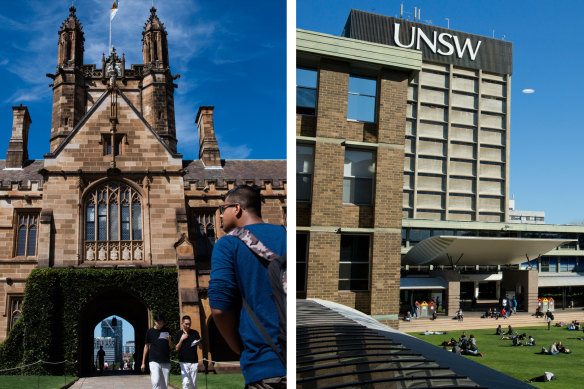This was published 8 months ago
Revealed: Where every Australian university sits in global rankings
Sydney University has reached a new high in the latest global rankings as one of three Australian universities making it into the top 20, but experts warn the government’s international student crackdown will cause institutions to fall down league tables.
Melbourne University remains the top-ranked Australian institution, rising one place to 13th in the world in the 2025 Quacquarelli Symonds (QS) rankings.

Two NSW universities, the University of Sydney and UNSW, are in the top 20 in the QS rankings.Credit: Louise Kennerley, Ryan Stuart
Sydney University rose one place to 18th – its highest-ever ranking – just pipping its rival University of NSW in 19th place.
University of Technology Sydney was the only other NSW university in the top 100, climbing two spots from 90 to 88. Macquarie University, University of Wollongong, and Western Sydney University all slipped in the rankings.
For the 13th consecutive year, the Massachusetts Institute of Technology in the US maintained its reign at the top of the rankings run by education analysts QS.
UK institutions Imperial College London and the University of Oxford were second and third. Harvard University and University of Cambridge rounded out the top five.
While two-thirds of US institutions declined in rank year-on-year, and only 22 per cent of British universities improved their rank, almost half of Australia’s entrants (47 per cent) improved in the 2025 edition.
“In the face of accelerating advancements from Asian institutions, Australian higher education has demonstrated remarkable resilience,” the report said.
But Angel Calderon, director of strategic insights at RMIT University and member of the QS Global Rankings Advisory Board, said the proposed international student cap would severely impact the viability of Australian universities and threaten the country’s standing as one of the “big four” study destinations along with the US, UK and Canada.
The proposed cap is central to the government’s plan to slash migration but has faced fierce opposition from the higher education sector which financially relies on international student fees.
“The cap on international students will hinder our place in the global rankings and therefore it will hinder our reputation and hinder the ability to attract international students,” Calderon said.
Australian universities ranked poorly in areas like employability and teaching, with no local institution in the global 300 for academic and student ratios.
More than 80 per cent of local universities also recorded lower year-on-year scores for employment outcomes and 76 per cent received lower scores from worldwide employers.
The rankings of 1500 universities are based on the analysis of more than 17.5 million academic papers and surveys from 175,798 academics and 105,476 employers.
Australian National University higher education expert Andrew Norton said rankings like QS’s fuelled perverse behaviour among universities.
“[Universities] ridiculously obsess over them and I think it distorts their decision-making. Including the recent merger of two institutions in South Australia,” he said.
“International students make decisions based on research rankings but they are not very indicative of the quality of their student experience.”
Norton said the proposed international student caps would lead to a fall in international rankings, which have a heavy weighting on research capacity.
“We have relied on profits from international students to increase our research output, and as their numbers fall that will start to reverse itself. It may take a couple of years to show because research is a lag indicator,” he said.
“[These rankings] are very important to the international student market, particularly for the Chinese market which is very prestige-focused, to the point where it’s probably the single biggest factor in choosing an institution.”
QS chief executive Jessica Turner said tighter regulations could prompt several thousands of prospective international students to look beyond Australia, threatening a $48 billion export sector that relied heavily on international student fees to fund research and maintain its cutting-edge status.
“It is important to balance regulatory measures with the need to support the international education sector and the opportunities it provides,” she said.
With Robyn Grace
Start the day with a summary of the day’s most important and interesting stories, analysis and insights. Sign up for our Morning Edition newsletter.
Explore Campus - our new student hub
How the changes to higher education debts will affect you
Unpaid internships are one thing, but paying to work? That’s absurd
Thousands of Australians want a place at a top US university. Here’s how Rizina got hers
Use our interactive search tool below to research courses across Australia: